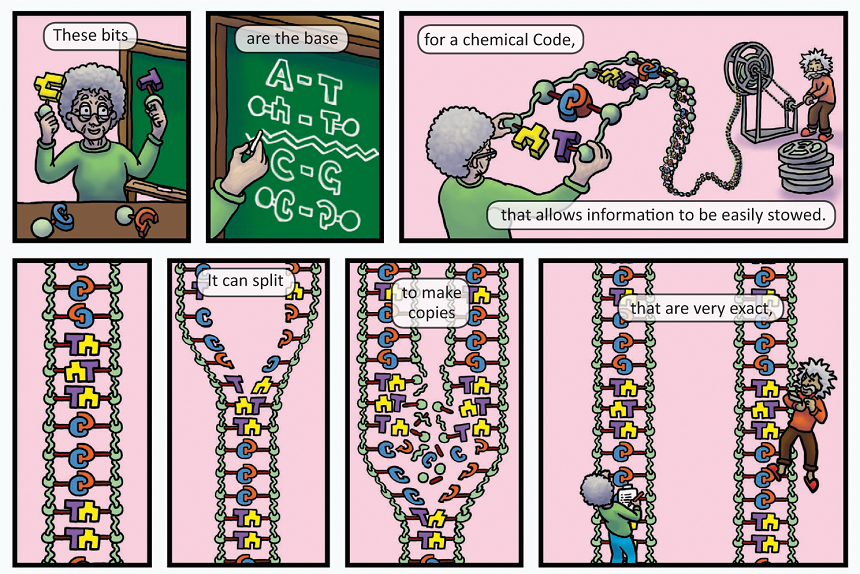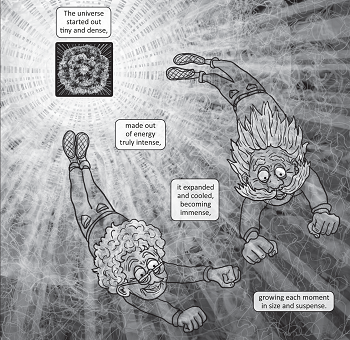Book review: The Universe Verse
A comic book draws in readers large and small; its drawings and poetry teach science to all

The Universe Verse combines rhyming and art, to create science explanations that set it apart.
J. Dunbar/http://www.jldunbar.com/
It’s time to write just a short review
Of a book about science that’s shiny and new.
Comics and rhyme for the science loving and averse
This book’s aptly titled “The Universe Verse”
Because while nice pictures and diagrams might well do
Why not have fun and add poetry, too?
Some science books feature cartoons to help explain important concepts. Others focus on illustrations or diagrams. But only one provides a broad mix of diagrams, cartoons — and poetry. In 2013, James Lu Dunbar launched a campaign to turn his rhyming comics about the universe into a book. Now, his 90-page poetic ode is here: “The Universe Verse.”
With illustrations and gentle humor, a pair of sweet, science-loving grandparents guide readers through some of the important concepts in our world. They lay out the story in three parts. Cartoons in black and white launch the story, illustrating the creation of the universe. As the book moves on, the focus turns to Earth and the origins of life — and the imagery explodes into color. The third section covers our own origins, from the first cells to how people evolved.

But in the second and third sections, the color illustrations are inviting, concise and helpful. The poetry becomes both charming and memorable. Some phrases stick in my head for their clarity. One favorite:
“DNA’s great power is that it can talk,
As a code for aminos, life’s building block.
There are twenty amino acids that life forms must stock,
DNA orders them, they fold and interlock.
The resulting structure is called a protein.
They’re the pieces and parts of each living machine.
All the DNA that makes one is part of one gene.”
This is a great description of how DNA contains genes to make the proteins that help cells live and function. The rhyming may not be the best, but it helps me to remember the concepts. And the accompanying illustrations are both charming and accurate.
There are a few hiccups in the second and third parts. Photosynthesis — how cells and plants can convert sunlight into food —is mentioned and described twice. This is because the three sections were originally written separately. A bit more editing would have made these sections flow more seamlessly.
But overall, I simply must say
This book is quite beautiful in an artistic way.
It’s art, verse and science to feed your brain
It’s definitely a book I was glad to obtain.
Right now, the PDF eBook is free to download for the month of December.
The hardcover version by James and Kenneth Publishers is $24.95, and from Amazon.com it’s $20.49.
Follow Eureka! Lab on Twitter
Power Words
amino acids Simple molecules that occur naturally in plant and animal tissues and that are the basic constituents of proteins.
DNA (short for deoxyribonucleic acid) A long, double-stranded and spiral-shaped molecule inside most living cells that carries genetic instructions. In all living things, from plants and animals to microbes, these instructions tell cells which molecules to make.
force Some outside influence that can change the motion of a body or produce motion or stress in a stationary body.
gene (adj. genetic) A segment of DNA that codes, or holds instructions, for producing a protein. Offspring inherit genes from their parents. Genes influence how an organism looks and behaves.
photosynthesis (verb: photosynthesize) The process by which green plants and some other organisms use sunlight to produce foods from carbon dioxide and water.
proteins Compounds made from one or more long chains of amino acids. Proteins are an essential part of all living organisms. They form the basis of living cells, muscle and tissues; they also do the work inside of cells. The hemoglobin in blood and the antibodies that attempt to fight infections are among the better known, stand-alone proteins. Medicines frequently work by latching onto proteins.